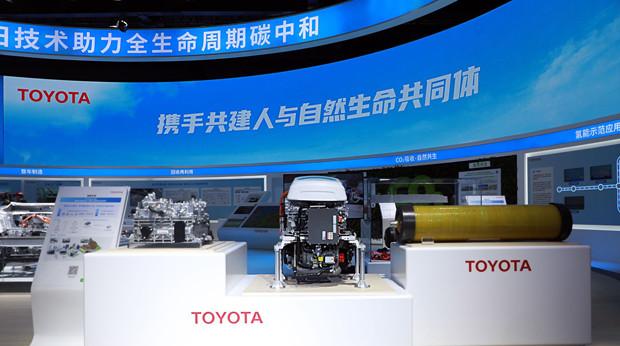In recent years, carbon neutrality has gradually become one of the topics of common concern of the international community, and China has also established the goal of carbon peaking and carbon neutrality this year, and has helped environmental protection in an all-round way with various initiatives. In the field of transportation and travel, China is ushering in energy reform with the world and entering the stage of industrial transformation and upgrading.

As a world-renowned automobile company, Toyota Motor has focused its vision on the topic of a community with a shared future for mankind, quietly laid out in a forward-looking manner, developed more advanced technologies and products, and actively challenged the zero carbon dioxide emissions of new cars and vehicles throughout their life cycle to cope with the stringent environmental protection requirements of the Chinese market and "mass production happiness" for all mankind.
Hybrid first has been very effective
Before the "double carbon" goal was proposed, Toyota Motor has been deeply engaged in the field of energy conservation and emission reduction for a long time. As early as 1992, Toyota Motor issued the Toyota Global Environment Charter, and in 1997 produced its world's first mass-produced hybrid model, the PRIUS Prius, and in 2014, it took the lead in launching its world's first mass-produced hydrogen fuel cell vehicle MIRAI. By 2015, Toyota Motor corporation released the "Environmental Challenge 2050" strategy, focusing on global resources and environmental issues, with the goal of "making the negative impact of automobiles infinitely close to zero" and "bringing positive energy to society", and launched six challenges in the three major areas of "building better cars", "better production activities", and "better cities and beautiful society", one of which is zero carbon dioxide emissions for new cars and vehicles throughout their life cycle.
At present, Toyota Motor actively promotes the technological progress and popularization of HEV (dual engine), PHEV (dual engine E+), EV (E into the engine), FCEV (hydrogen engine) and other technologies, providing diversified choices for Chinese consumers and even the global market in an all-round way, hoping that consumers can freely choose travel services and products that take into account "sustainable development and practicality" according to different regions, different purposes and different use scenarios.
As of 2021, Toyota Motor has launched pure electric models such as C-HR EV and Yize E Jinqing in the Chinese market, as well as a rich lineup of dual-engine models such as Corolla, Camry, Leiling, Rongfang, and Asia Dragon, which are very popular. At the same time, Toyota motor has sold more than 18 million HEVs worldwide, and its battery capacity is equivalent to about 260,000 EVs, but the CO2 emission reduction effect is equivalent to about 5.5 million EV.
Electric forward and then set an example
At this year's Shanghai International Auto Show, Toyota Motor exhibited the TOYOTA bZ4X CONCEPT, the first global mass-produced model of the TOYOTA bZ pure electric exclusive series, and the mirai II, a hydrogen fuel cell vehicle.
It is worth mentioning that as the first model developed by Toyota e-TNGA, TOYOTA bZ4X not only brings better than the same level of interior space and smoother driving experience, while effectively using energy recovery, but also installed solar panels on the panoramic sunroof, with the solar charging system, can be flexibly charged when parking, improve the range and fuel economy of EVs, and further strengthen the environmental advantages of new energy vehicles.
According to the plan, Toyota Motor will introduce 35 new electrified models by 2025, and strive to account for 50% of the total sales of electrified vehicles in 2025, an increase of 50% compared with 2020, so that consumers can recognize a new Toyota motor.
At the same time, as the mobile partner of next year's Beijing Winter Olympics, Toyota Motor will provide the mirai II. and Costa hydrogen engines for the event, as well as a variety of BEV and HEV models, all of which are energy-saving and clean energy vehicles, and account for 85.84% of all vehicles, helping the Beijing Winter Olympics to become the winter Olympics with the lowest carbon emissions in history.
Technology is fueled by zero carbon emissions
To achieve carbon neutrality, Toyota knows that it cannot rely solely on vehicle technology advancements, because the automotive industry must reduce carbon dioxide emissions from vehicle production and use to recycling. To this end, Toyota from the perspective of the whole life cycle, constantly explore and strive to achieve the ultimate, and strive to reduce carbon dioxide emissions in all aspects.
In the production process, after some efforts, Toyota Motor's plant in China will reduce carbon dioxide emissions from bicycle production by 46% and waste by 88% compared with 2006 in 2020, becoming a veritable "green factory". At the same time, Toyota Motor's core dealerships have also begun to use green electricity and promote energy-saving measures to 1,500 dealerships across the country. Not only that, Toyota Motor has also been carrying out tree planting activities since 2001, and has planted 6 million trees so far, and has not taken precautions to develop the recycling and reuse of waste batteries.
But it is impossible for a single company to be carbon neutral, and it is even more necessary to work together with like-minded partners. Toyota Motor will continue to expand the scope of external supply of HEV systems and FC systems to more Chinese companies, and expand cooperation in areas such as autonomous driving, new energy, MaaS, and recycling of waste batteries, and strive to achieve 100% localization of core components for electrification.
(Xinmin Network publishes this article for the purpose of transmitting automobile information, which does not represent the views of this website)